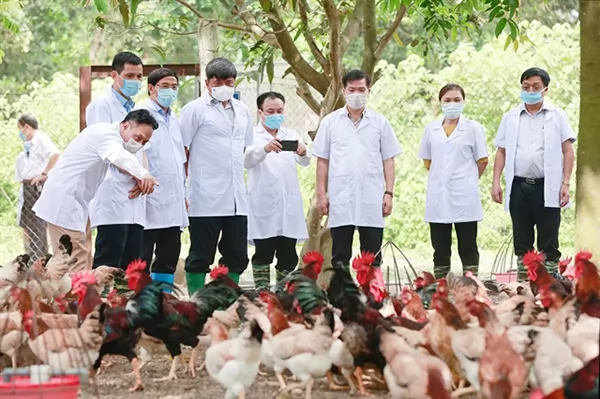Price of poultry meat plummets

Price of chicken meat has fallen sharply on the domestic market, especially white-feather chicken. — Photo cafef.vn
HÀ NỘI — Prices of chicken and duck meat have plummeted on the domestic market over the past two weeks due to epidemics of novel coronavirus (Covid-19) and the A/H5N6 avian influenza, according to traders.
Nguyễn Văn Toàn, a trader at the Hà Vy Wholesale Market in Thường Tín District, Hà Nội, said over the past two weeks, the price of coloured-feather chicken dropped sharply to VNĐ46,000-50,000 (US$1.95-2.12) per kilo from VNĐ65,000-70,000 before the Tết holiday.
The strongest reduction was in the price of white-feather chicken and duck meat, falling 50 per cent to VNĐ17,000-20,000 per kilo against those before Tết.
The farmers have suffered huge losses from the price reduction because the production cost at present is VNĐ24,000-26,000 per kilo for white-feather chicken and VNĐ30,000-32,000 per kilo for duck, he said.
Meanwhile, according to Toàn, poultry consumption has also decreased by at least 50 per cent. He usually sold 1-2 tonnes of chicken per day, but now, the volume is 600 kilo per day, meaning he is unable to afford rent and transport.
Trần Văn Hùng in Tam Đảo District, Vĩnh Phúc Province, said Vĩnh Phúc leads in the number of people affected by the acute respiratory illness Covid-19 (nCoV), thus traders are afraid to come to this northern province to buy chicken and duck.
The chicken prices have dropped to VNĐ50,000-80,000 per kilo depending on kinds of chicken, he said. The consumption has also fallen to an average of 600 kilos of chicken per day at present, from two tonnes per day before the coronavirus epidemic.
Farms in Đồng Nai, Bình Dương and Bà Rịa – Vũng Tàu have also seen the same issue. The prices of chicken and duck stood at VNĐ25,000-26,000 per kilo of white-feather chicken before the Tết holidays and those prices plunged to VNĐ21,000-22,000 per kilo after Tết. They have even dropped to VNĐ12,000-13,000 per kilo at present, the lowest level in recent years, according to the Ministry of Agriculture and Rural Development.
Nguyễn Kim Đoán, vice chairman of the Đồng Nai Livestock Association, said the price reduction is due to higher supply of poultry meat. The farmers have changed to breed poultry as the African swine fever has affected pig herds on the domestic market.
All schools are closed due to the coronavirus epidemic, causing reduction in poultry meat demand at schools as well as poultry prices.
The same situation has also happened when all festival activities have stopped due to the coronavirus epidemic.
Meanwhile, many farmers are worried about the A/H5N6 avian influenza and they have sold their poultry, causing traders to push prices of poultry down.
According to the livestock industry’s experts, the prices will likely recover if all activities are resumed. VNS
Maybe you are interested

High-tech shrimp farming brings high profits in Bạc Liêu Province
BẠC LIÊU — The Cửu Long (Mekong) Delta province of Bạc Liêu plans to expand super - intensive shrimp farming as it is sustainable and offers high production value.

Agricultural innovation key to capital's food security
HÀ NỘI — High-value specialty crops and livestock are being developed to meet the increasing consumption needs of domestic consumers, in line with the comparative advantage of each locality, but more needs to be done, Deputy Minister of Agriculture and Ru

Cà Mau tightens regulations on use of geographical indication for black tiger shrimp
CÀ MAU - The southernmost province of Cà Mau has strengthened regulations on the use of Cà Mau geographical indication for its black tiger shrimp to protect the rights of shrimp breeders and consumers.





